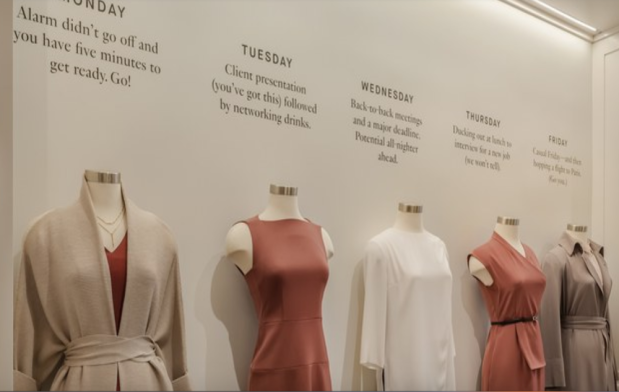MM.LaFleur And Designing Spaces Where Shoppers Actually Want To Be

Finding herself staring at a sea of fairly nondescript pantsuits to wear to work, MM.LaFleur Founder Sarah LaFleur realized she wanted better options – clothing that better spoke to her personality, clothing that said something. And, hopefully, clothing she could shop for without having to hand over hours of her life to searching the racks of department stores after-hours trying desperately to find something interesting to wear.
“It was just horrible,” LaFleur told Architectural Digest. “You’re clawing through thousands of square feet of racks to find one item that might work for you. It was such a pain point in my life.”
A pain point she was determined to solve – though, by her own description, she is a business person, not a design person. Which meant that when it came to launching a clothing company, she was going to need some help. And she found that help in the form of Co-founder Narie Foster and Designer Miyako Nakamura, formerly of Zac Posen. In 2013, they launched their firm, MM.LaFleur, with a line of pencil skirts, dresses and tops that would be appealing and versatile enough to wear to work on the regular, while also being comfortable and machine-washable so they didn’t become a burden or an errand for their owners.
While not a subscription service, per se, the company does bear at least a passing resemblance to one. Consumers are sent a “bento box” of work clothes in any month they chose to order it. Those boxes, which come with wardrobe pieces and accessories, are created by the firm’s stylists based on a survey users fill out during their first visit. Clothes in the box range from $110 to $365. The customer has four days to return any items they don’t like, and are only charged for those they keep. If they decide to take a pass on the box in its entirety, they are charged a $25 fee.
MM.LaFleur also has showrooms in New York City, Chicago and Washington, D.C. that provide in-person styling from the brand’s collection. Caroline Brown, associate director of visual merchandising, noted that the expansion into physical retail was the natural next step for the firm, which not only wants to offer a better product assortment to its customers, but also a better shopping experience.
“First you have Sarah [LaFleur, who founded the company with Narie Foster and Designer Miyako Nakamura], realizing there are no cool clothes for young professional women, and she fixes that,” Brown said. “Then she realizes that many of these women actually hate shopping. So that’s where I come in. The way we design our stores is so they feel like a home. I want people to walk in and feel comfortable, but also maybe a little bit confused. Like, I thought this was a store?”
The confusion Brown describes comes from the fact that when one walks into an MM.LaFleur showroom, merchandise is less than totally apparent. LaFleur noted that when they were first conceptualizing their physical spaces, first as pop-up shops and then as permanent stores, they wanted to get away from that cluttered, claustrophobic, clawing-through-the-racks experience that she mostly associated with clothing shopping. Instead, they wanted the consumer to walk into a relaxing space, with nary a rack or merchandise to be seen.
Instead, the in-store model is a bit like shopping online, with a bit of pampering thrown in. The customer fills out their questionnaire for a stylist to review, and then books an hour-long appointment at the showroom to see and try on the pieces the stylist has pulled for them based on their preferences.
MM.LaFleur encourages customers to take the whole hour, ensuring they are kept comfortable during the visit with champagne, slippers and the use of a vanity if needed. Fitting rooms are also designed around comfort, featuring light wood, brass detail and soft yellow lighting, as opposed to the bright white fluorescents that have become de rigueur in most fitting rooms.
“I feel like I’m just designing a space I want to be in,” LaFleur explains. “Everything is so boring these days; everyone does the same thing. I never think to myself, ‘I want to be in this store.’ I love libraries, hotel lobbies, spaces that really entice you. That’s what we wanted to do with our showroom.”
